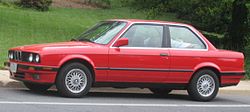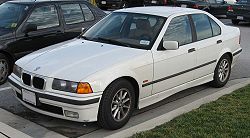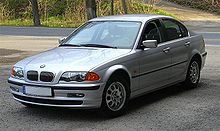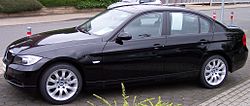BMW 3 Series
| BMW 3 Series | |
|---|---|
 | |
| Overview | |
| Manufacturer | BMW |
| Production | 1975–present |
| Assembly | Munich, Germany Regensburg, Germany Rosslyn, South Africa |
| Body and chassis | |
| Class | Entry-level luxury car / Compact executive car |
| Chronology | |
| Predecessor | BMW 2002 |
The BMW 3 Series is an entry-level luxury car / compact executive car manufactured by the German automaker BMW since May 1975. It was the successor to the 2002 coupe, retaining much of that car's styling while adding a more powerful 2.0 L 110 hp (82 kW) engine and other performance enhancements. The 3 Series was for some time the smallest car line manufactured by BMW (exempting the BMW-owned MINI), although that place was in 2004 taken by the BMW 1 Series. The 3 Series is BMW's best selling automobile, accounting for nearly 40% of all automobiles sold by the company in 2005. [1]. The 3 Series is the best selling luxury sedan in the United States — 98,000 vehicles were sold in 2005 [1].
Social and marketing significance
From its sporting origins, the 3 Series success has led BMW to become on of the most recognized brands in the world, in league with Coca-Cola, IMB, The Four Seasons, and American Express. Being an accessible prestige-badge car, the 3 Series' reputation grew from it's humble beginnings, winning numerous awards and honors throughout the automotive world. By the early 21st century, the E46 3 Series was the best-selling car of its size in the world, as commonplace in Asia and America as in Europe, while maintaining its prestigious brand and image.
The 3 series has also maintained BMW's racing heritage. The M version of the 3 series, M3, debuted in the 1980's as an industry first "track ready" luxury sports car. Marketed as a daily driver and a track ready race car, the M3 grew in popularity quickly. This has furthered the 3 series brand awareness as a class-leading "sport sedan".
History
In the late 1960s, performance car enthusiasts in the U.S. had limited options. There were small 2-seater sports cars like the British MG. And there were Detroit-made muscle cars with big V-8 engines offering a lot of power, but little else. Few Americans had ever heard the name BMW.
Then in 1968, an article appeared in Car & Driver magazine, raving about an unassuming little automobile: the BMW 2002. This was a car Americans had never seen, and a glimpse of what Europeans already enjoyed. It accelerated like a muscle car, but it was light and fuel-efficient. It was agile like a sports car, but it had four quite comfortable seats and legroom. The 2002 embodied for Americans an entirely new concept: the sports sedan. And it laid down track that BMW has been running on ever since. Historically, BMW got its start in the American market in New York City, thanks to an Austrian named Max Hoffman.
Max Hoffman, often referred to as the "father" of the import car business, was a famous New York Car Dealer/Importer who is largely responsible for the US sports car resurgence of the 40's and 50's. He imported sports cars to the US and made them available after WW II. Hoffman helped sponsor amateur sports car racing in the US and encouraged the European manufacturers to respond to the emerging US sports car market. Hoffman influenced BMW product marketing (as well as other German made cars )in the US for many years.
The success of the 2002 led to the founding of BMW North America in 1975. And shortly thereafter a new model was introduced that furthered this concept of performance and practicality – the BMW 3 Series. This new model was a direct descendant of the 2002. The 3 series is the most successful of BMW models, a trend that will likely continue well into the future.
Through model evolution, the 3 series has expanded upwards and outwards – but for BMW, the 3 Series remains the defining car and the benchmark against which all future designs will be judged.
3 Series vehicles can be largely differentiated by the underlying platform:
- BMW E21 - (1975–1983) 3 Series
- BMW E30 - (1984–1994) 3 Series
- BMW E36 - (1992–1998) 3 Series
- BMW E46 - (1999–2005) 3 Series
- BMW E46 - (2006) 3 Series Convertible
- BMW E90 - (2006–) 3 Series Sedan
- BMW E91 - (2006-) 3 Series Wagon
- BMW E92 - (2007-) 3 Series Coupé
- BMW E93 - (2008-) 3 Series Convertible
E21
| E21 | |
|---|---|
 | |
| Overview | |
| Production | 1975–1983 |
| Body and chassis | |
| Body style | 2-door coupe 2-door convertible |
| Layout | FR layout |
| Powertrain | |
| Engine | 1.6 L 75 hp M41 I4 1.6 L 90hp M41 I4 |
The E21 line was produced from 2 May, 1975 (1977 in the USA) through 1983. Originally a replacement for the 2002 coupe, the first 3-Series was a 2-door model only. The New Class sedans would be replaced by the 5 Series. A factory authorised cabrio version was built by Baur.
Models:
- Europe
- 1981-1983 315 - 1.6 L M41 I4, 75 hp (55 kW)
- 1975-1979 316 - 1.6 L M41 I4, 90 hp (66 kW)
- 1980-1983 316 - 1.8 L M10B18 I4, 90 hp (67 kW)
- 1975-1980 318 - 1.8 L M42 I4, 98 hp (72 kW)
- 1979-1983 318i - 1.8 L M42 I4, 105 hp (77 kW)
- 1975-1979 320/4 - 2.0 L M64 I4, 109 hp (80 kW)
- 1975-1979 320i - 2.0 L M10B20 I4, 125 hp (92 kW)
- 1979-1982 320/6 - 2.0 L M20B20 I6, 122 hp (89 kW)
- 1978-1982 323i - 2.3 L M20B23 I6, 143 hp (105 kW)
- Rest of world
E30
| E30 | |
|---|---|
 | |
| Overview | |
| Production | 1984–1994 |
| Body and chassis | |
| Body style | 2-door coupe 2-door convertible 4-door sedan 4-door station wagon |
| Layout | Front engine, rear-wheel drive / All-wheel drive |
| Related | BMW M3 |
| Powertrain | |
| Engine | 2.5 L 168 hp I6 |
| Transmission | 4-speed automatic 5-speed manual |
| Dimensions | |
| Wheelbase | 101.2 in |
| Length | 170.3 in (sedan & station wagon) 175.2 in (coupe) |
| Width | 64.8 in |
| Height | 54.3 in (sedan) 55.4 in (coupe & station wagon) |
The E30 was sold from 1982 through 1991 in sedan form, through 1993 in convertible form. The E30's introductory price of US$18,210 was nearly double that of the E21 just 7 years earlier, but the availability of a six cylinder engine and 4-door body style (in 1984) earned sales. The torquey "eta" six in the 325e produced 121 hp (90 kW), but met the strict emission standards of the time. The E30 was the most powerful compact BMW offered in the United States since the 2002 Tii.
The lineup was joined in 1985 by the high-output 325i and 325is. Though the engine displacement was reduced to 2.5 L, output was up to 168 hp (125 kW) as the company focused on performance rather than economy. The rev limit for the new motor was raised from 5000 rpm to 6500 rpm, as a shorter stroke was employed with the new motor.
An all wheel drive version, the 325ix, joined the lineup for 1986. The four-cylinder 318 was dropped in 1985, but was brought back with a new, 1.8L DOHC motor (M42B18) for 1991.
In 1989, BMW introduced the touring version of the E30. It was very popular during its production up to 1994. It was available with a 1.6, 1.8, 2.0 or 2.5 liter engine. The 325i touring was also available with 4WD.
The most powerful American BMW E30 in 1989 came in the form of the M3. It used a 192 hp (143 kW) S14 straight-4 with a 4-valve head adapted from the M88 six and Bosch fuel injection.
Models:
- Europe
- 1982-1987 316 - 1.6 L M98 I4, 90 hp (66 kW)
- 1982-1990 316 1.8 - 1.8 L M10B18 I4, 90 hp (66 kW)
- 1987-1993 316i - 1.6 L M40B16 I4, 102 hp (75 kW)
- 1982-1987 318i - 1.8 L M10B18 I4, 105 hp (77 kW)
- 1987-1993 318i - 1.8 L M40B18 I4, 115 hp (85 kW)
- 1989-1991 318is - 1.8 L M42B18 I4, 140 hp (103 kW)
- 1982-1985 320i - 2.0 L M20B20 I6, 125 hp (92 kW)
- 1985-1991 320i - 2.0 L M20B20 I6, 129 hp (95 kW)
- 1988-1990 320is - 2.0 L S14 I4, 192 hp (141 kW)
- 1982-1986 323i - 2.3 L M20B23 I6, 150 hp (110 kW)
- 1985-1991 325i - 2.5 L M20B25 I6, 170 hp (125 kW)
- 1986-1991 325iX - 2.5 L M20B25 I6, 170 hp (125 kW)
- 1986-1988 M3 - 2.3 L S14 I4, 200 hp (147 kW)
- 1989-1991 M3 Evo - 2.5 L S14 I4, 215 hp (158 kW)
- 1985-1991 324d - 2.4 L M21 I6, 86 hp (63 kW)
- 1987-1991 324td - 2.4 L M21 I6, 115 hp (85 kW)
- Other markets
- 1984-1985 318i - 1.8 L M10B18 I4, 101 hp (75 kW) - North America
- 1991 318iS - 1.8 L M42B18 I4, 134 hp (100 kW) - North America
- 1984-1991 325e - 2.7 L M20B27 I6, 121 hp (90 kW) - North America
- 1986-1991 325es - 2.7 L M20B27 I6, 121 hp (90 kW) - North America
- 1987-1991 325i/is - 2.5 L M20B25 I6, 168 hp (125 kW) - North America
- 1988-1991 325ix - 2.5 L M20B25 I6, 168 hp (125 kW) - North America
- 1988-1991 M3 - 2.3 L S14 I4, 192 hp (143 kW) - North America
- 1984-1990 333i - 3.2 L M30 I6, 197 hp (145 kW) - South Africa
- 1989-1991 325iS - 2.7 L, 197 hp (145 kW) - South Africa
- 1991-1992 325iS - 2.7 L, 210 hp (155 kW) - South Africa
- External Links
- M42Club.com is a model-specific forum and community for the E30 318i/iS.
E36
| E36 | |
|---|---|
 | |
| Overview | |
| Production | 1991–2000 |
| Body and chassis | |
| Body style | 2-door coupe 2-door convertible 4-door sedan 4-door station wagon 2-door hatchback |
| Layout | Front engine, rear-wheel drive / Four-wheel drive |
| Related | BMW M3 |
| Powertrain | |
| Engine | 1.9 L, 138 hp I4 2.8 L, 190 hp I6 |
| Transmission | 4-speed automatic 5-speed manual |
| Dimensions | |
| Wheelbase | 106.3 in |
| Length | 165.7 in (hatchback) 174.5 in (coupe & sedan) |
| Width | 66.9 in (hatchback & sedan) 67.3 in (coupe) |
| Height | 54.8 in (hatchback & sedan) 53.8 in (coupe) |
Also known as the "Dolphin shape." The E36 was sold from 1991 through 1998. It employed the "Z-axle" multilink suspension in the rear which had been proven in the Z1. DOHC engines were used across the range, with VANOS variable valve timing introduced in 1993.


The four-door E36 was sold from Autumn, 1991, in the United States but the E30 coupes were retained until well into 1992. The E36 convertible was delayed until 1994. The hatchback 318ti Compact was introduced in 1995, was very popular in Europe, but it was not very successful in North America. The BMW Compact was identical to the regular E36 sedan from front bumper to A-Pillar. Everything else was unique, namely its rear semi-trailing arm suspension, based off the old E30, instead of the Z-Axle Multilink employed in all other E36's. The Z3 and M Coupe have similar rear suspension setups as well. The "Touring" station wagon was sold in Europe from 1995, but was not offered in the United States.
The 2.5 L M50B25 used in the 325 models was replaced in 1996 with the 2.8 L M52B28, creating the 328 line. Another 2.5 L engine, the M52B25, was reintroduced for 1998 but the cars were sold as 323 rather than 325.
The 4-door 3 Series models were replaced after 1998 in the US, while the 2-door models lasted through 1999.
Models:
- Europe
- 1991-1994 316i - 1.6 L M40B18 I4, 102 hp (76 kW)
- 1995-1999 316i - 1.6 L M43B16 I4, 102 hp (76 kW)
- 1991-1999 318i - 1.8 L M40B18 I4, 115 hp (86 kW)
- 1995-2000 318iS/ti - 1.9 L M44B19 I4, 138 hp (103 kW)
- 1991-1995 320 - 2.0 L M50B20 I6, 150 hp (112 kW)
- 1992-1997 M3 - 3.0 L S50B30 I6 286 hp
- 1993-1997 323 - 2.4 L M50B24 I6 170 hp
- 1994-1999 320 - 2.0 L M52B20 I6
- 1994-1999 324 - 2.4 L M52B24 I6
- 1991-1995 325 - 2.5 L M52B25 I6 192 hp
- 1995-2000 328 - 2.8 L M52B28 I6 193 hp
- 1995-2000 M3 - 3.2 L S50B32 I6 321 hp
- US
- 1992-1995 318iS - 1.8 L M42B18 I4, 134 hp (100 kW)
- 1995-1999 318ti - 1.8 L M42B18 I4, 134 hp (100 kW)
- 1992-1995 325 - 2.5 L M50B25 I6, 189 hp (125 kW)
- 1995 M3 - 3.0 L S50B30US I6, 247 hp (184 kW)
- 1996-1999 M3 - 3.2 L S52B32 I6, 247 hp (184 kW)
- 1996-1999 328 - 2.8 L M52B28 I6, 190 hp (142 kW)
- 1996-1999 318 - 1.9 L M44B19 I4, 138 hp (103 kW)
- 1998 323 - 2.5 L M52B25 I6, 168 hp (125 kW)
E46
| E46 | |
|---|---|
| BMW 3-Series Sport (previous generation, update) | |
| Overview | |
| Production | 1998–2005 |
| Body and chassis | |
| Body style | 2-door coupe 2-door convertible 4-door sedan 4-door station wagon |
| Layout | Front engine, rear-wheel drive / All-wheel drive |
| Related | BMW M3 BMW X3 |
| Powertrain | |
| Engine | 2.5 L 170 hp I6 2.8 L 193 hp I6 |
| Transmission | 5-speed automatic 5-speed manual |
| Dimensions | |
| Wheelbase | 107.3 in |
| Length | 176 in (sedan) 176.7 in (coupe) |
| Width | 68.5 in (sedan) 69.2 in (coupe) |
| Height | 55.7 in (sedan) 54.6 in (coupe) |





The E46 chassis began to replace the E36 specification for 1998. Only the 4-door sedans were updated that year. The E36 coupé and touring models lasted one more year until the E46 replacements arrived for model year 2000. The 2.8 L cars were called 328 while 2.5 L cars got the confusing 323 name. The new M54 engines appeared for 2001; with the new 3.0 L 330 replacing the 328, BMW renamed the 2.5 L car the 325. Also in 2001, the compact 3-door version appeared on the european market, but it was replaced in 2004 by the 1 series. During the second half of 2005 the E46 sedan and touring were phased out in favour of the new E90. The E46 coupé and convertible remain in production well into 2006. The E46 Coupe & Convertible used a "ci" (standing for coupe/convertible) instead of "i".
Models:
- Europe and other markets
- 1998-2001 316i - 1.9 L, M43TUB19, 105 hp (77 kW)
- 2001-2005 316i - 1.8 L N42B18, 116 hp (87 kW)
- 1998-2001 318i - 1.9 L, 118 hp (87 kW)
- 2001-2005 318i - 2.0 L N42B20, 143 hp (105 kW)
- 2005-2006 318Ci - 2.0 L N42B20, 150 hp (110 kW)
- 1998-2000 320i - 2.0 L M52B20 T, 150 hp (110 kW)
- 2000-2006 320i - 2.2 L M54B22, 170 hp (125 kW)
- 1998-2001 323i - 2.5 L M52B25 T, 170 hp (125 kW)
- 1998-2001 328i - 2.8 L M52B28 T, 193 hp (142 kW)
- 2000-2006 325i - 2.5 L M54B25, 192 PS
- 2000-2006 330i - 3.0 L M54B30, 231 PS
- 2000-2003 M3 - 3.2 L S54B32, 343 PS
- US
Diesel models:
- 1998-2001 320d - 1951 cc, 136 hp (100 kW)
- 2001-2006 320d - 1995 cc, 150 hp (110 kW)
- 1998-2003 330d - 2926 cc, 184 hp (135 kW)
- 2003-2006 330d - 2993 cc, 204 hp (150 kW)
E90
| E90 | |
|---|---|
 | |
| Overview | |
| Production | 2006–present |
| Body and chassis | |
| Body style | 2-door coupe 2-door convertible 4-door sedan 4-door station wagon |
| Layout | Front engine, rear-wheel drive / all-wheel drive |
| Related | BMW M3 BMW X3 |
| Powertrain | |
| Engine | 2.5 L 184 hp I6 3.0 L 215 hp I6 |
| Transmission | 5-speed automatic 5-speed manual |
| Dimensions | |
| Wheelbase | 108.70 in |
| Length | 180.30 in (coupe) 178.2 in (sedan) |
| Width | 69.20 in (coupe) 71.5 in (sedan) |
| Height | 54 in (coupe) 55.9 in (sedan) |
The E90 began production in May 2005 as a 2006 model. Currently, four engine options are offered, two being part of the new 'N' series of BMW inline engines featuring a lightweight magnesium/aluminum construction and technological innovations such as individual cylinder throttles, steplessly variable valve timing, and dual stage intake timing. The 3-Series is manufactured in Regensburg, Munich, and Leipzig, Germany while only the coupe, convertible, and some sedans are manufactured in Regensburg. The E91 touring model has also been available since fall 2005 along with AWD models 325xi, 330xi and 330xd. The E92 2-door was released in September of 2006 along with BMW's new N54 twin-turbo engine.
As of 2006, the E90 outsells both the Ford Mondeo and Vauxhall Vectra in the United Kingdom, according to official SMMT figures.
Models:
- 2005- 316i - 1.6 L gasoline inline-four, 115 hp (85 kW)
- 2005- 318i - 2.0 L gasoline inline-four, 129 hp (95 kW)
- 2005- 318d - 2.0 L diesel inline-four, 122 hp (90 kW)
- 2005- 320i - 2.0 L gasoline inline-four, 150 hp (110 kW)
- 2006 320si - 2.0 L gasoline inline-four, 173 hp (126 kW). Limited production (2600 units worldwide).
- 2005- 320d - 2.0 L diesel inline-four, 163 hp (120 kW)
- 2006- 323i - 2.5 L (Canada, S Africa), gasoline inline-six, 174 hp (128 kW)
- 2006- 325i - 2.5 L gasoline inline-six 218 hp (160 kW)
- 2006- 330i - 3.0 L gasoline inline-six, 258 hp (190 kW)
- 2006- 325d - 3.0 L diesel inline-six, 197 hp
- 2006- 330d - 3.0 L diesel inline-six, 231 hp (170 kW)
- 2006- 335d - 3.0 L twin-turbo diesel inline-six, 286 hp
- 2007- 328i coupe - 3.0 L gasoline inline-six, 230 hp (169 kW) (271 N·m)
- 2007- 328xi coupe - 3.0 L gasoline inline-six, 230 hp (169 kW) (271 N·m)
- 2007- 335i coupe - 3.0 L twin-turbo gasoline inline-six, 306 hp (225 kW) and (400 Nm) 300 ft·lbf
- 2007- 328i sedan - 3.0 L gasoline inline-six, 230 hp (169 kW) (271 N·m)
- 2007- 328xi sedan - 3.0 L gasoline inline-six, 230 hp (169 kW) (271 N·m)
- 2007- 328xi touring - 3.0 L gasoline inline-six, 230 hp (169 kW) (271 N·m)
- 2007- 328i sportwagon - 3.0 L gasoline inline-six, 230 hp (169 kW) (271 N·m)
- 2007- 328i Hardtop Cabriolet - 3.0 L gasoline inline-six, 230 hp (169 kW) (271 N·m)
- 2007- 335i sedan - 3.0 L twin-turbo gasoline inline-six, 306 hp (225 kW) and (400 Nm) 300 ft·lbf
- 2007- 335xi sedan - 3.0 L twin-turbo gasoline inline-six, 306 hp (225 kW) and (400 Nm) 300 ft·lbf
- 2007- 335i Hardtop Cabriolet - 3.0 L twin-turbo gasoline inline-six, 306 hp (225 kW) and (400 Nm) 300 ft·lbf
- 2008- M3 coupe and sedan
In US:
- 2006 325i - 3.0 L I6, 215 hp. Sedan Only.
- 2006 325xi - 3.0 L I6, 215 hp. Sedan and Sport Wagon available.
- 2006 330i - 3.0 L I6, 255 hp. Sedan Only.
- 2006 330xi - 3.0 L I6, 255 hp. Sedan Only.
- 2007- 328i - 3.0 L I6, 230 hp. Sedan, Sport Wagon, Coupe, and Convertible available.
- 2007- 328xi - 3.0 L I6, 230 hp. Sedan, Sport Wagon, and Coupe available.
- 2007- 335i - 3.0 L I6, 300 hp. Sedan, Coupe and Convertible available.
- 2008- 335xi - 3.0 L I6, 300 hp. Sedan Only.
- 2008- M3 - 4.0 L V8, 420 hp. Coupe
- 2009- M3 - 4.0 L V8, 420 hp. Convertible
BMW produces a metal-topped coupé convertible[2] model of the 3 series (E93) rather than the traditional cloth-top convertible. This model will be introduced in 2007.
BMW will reportedly produce the E90 M3 in sedan form.
Note: The 325i and 330i are both powered by the same 3.0 L N52 engine, but the 330i features revised engine software and improved intake and exhaust systems to produce an additional 40 hp (255 vs. 215). Canada also gets a 323i model which has a detuned 2.5 L gasoline-injected inline-six producing 200 hp (149 kW). The new 335i uses a twin-turbo powerplant, also seen on the 5 series models.
Awards
The 3 Series has been on Car and Driver magazine's annual Ten Best list 16 times, from 1992 through 2007, making it the longest running entry in the list [3]. The E90 was named "Best New Sports Sedan" in the 2006 Canadian Car of the Year awards. Also, it was awarded the World Car of the Year at the New York Auto Show in 2006.
Racing
The E36 320d won the 24 Hours Nürburgring in 1998.
The E46 3-Series is the car that won Andy Priaulx and BMW Team GB the World Touring Car Championship in 2005. The E90 3-series repeated this feat in 2006. This is a highly advertised achievement of BMW. The WTCC is in the 'Big Three' FIA championships (along with Formula One and the World Rally Championship). The 3-Series' rear-wheel drive layout and its proven dynamics have both been attributed to its victory, though in Touring Car Racing, as almost every other motor sport, much of the skill is with the driver and their team tactics.
Throughout history, the 3-Series cars in the BTCC and other touring car championships have been penalised for being rear wheel drive and thus having better handling than competitors. The 320si has been penalised in the WTCC for this reason to keep the sport competitive with the rest of the grid (Ford Focus, Chevrolet Lacetti, SEAT Leon, Alfa Romeo 156) being front wheel drive. Despite these ballast weight penalties, the 320si's of the British, German and Italian/Spanish teams continually win races and points with their skilled drivers.
The BMW 3-Series is currently used in both the SCCA Pro Racing Speed World Challenge Touring Car Series and the Grand American Road Racing Series. In the final 2006 Grand Am standings, BMW finished second in the manufacturer's standings in both the Grand Sport and Street Tuner classes, and Turner Motorsport prepped E46 BMWs won the driver's and team championships.
